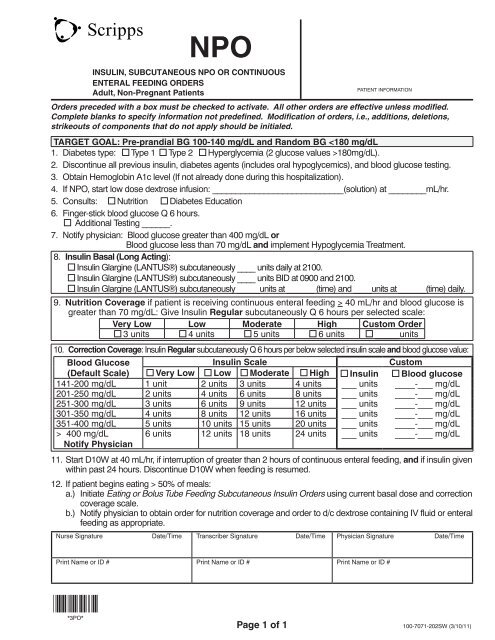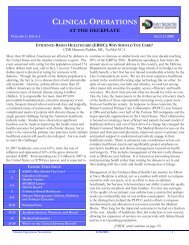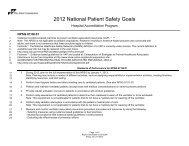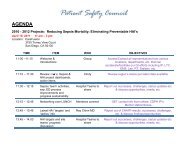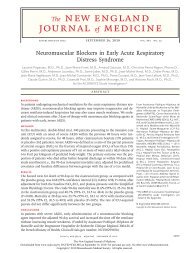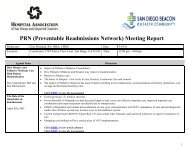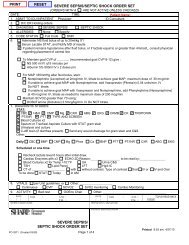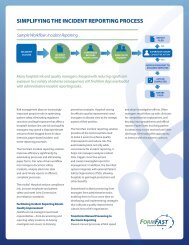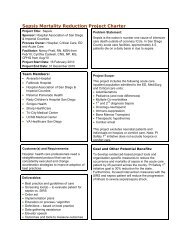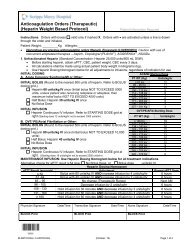Insulin, Subcutaneous NPO or Continuous Enteral Feeding Orders
Insulin, Subcutaneous NPO or Continuous Enteral Feeding Orders
Insulin, Subcutaneous NPO or Continuous Enteral Feeding Orders
You also want an ePaper? Increase the reach of your titles
YUMPU automatically turns print PDFs into web optimized ePapers that Google loves.
<strong>NPO</strong><br />
INSULIN, SUBCUTANEOUS <strong>NPO</strong> OR CONTINUOUS<br />
ENTERAL FEEDING ORDERS<br />
Adult, Non-Pregnant Patients<br />
PATIENT INFORMATION<br />
<strong>Orders</strong> preceded with a box must be checked to activate. All other <strong>or</strong>ders are effective unless modified.<br />
Complete blanks to specify inf<strong>or</strong>mation not predefined. Modification of <strong>or</strong>ders, i.e., additions, deletions,<br />
strikeouts of components that do not apply should be initialed.<br />
TARGET GOAL: Pre-prandial BG 100-140 mg/dL and Random BG 180mg/dL).<br />
2. Discontinue all previous insulin, diabetes agents (includes <strong>or</strong>al hypoglycemics), and blood glucose testing.<br />
3. Obtain Hemoglobin A1c level (If not already done during this hospitalization).<br />
4. If <strong>NPO</strong>, start low dose dextrose infusion: ____________________________(solution) at ________mL/hr.<br />
5. Consults: Nutrition Diabetes Education<br />
6. Finger-stick blood glucose Q 6 hours.<br />
Additional Testing ______.<br />
7. Notify physician: Blood glucose greater than 400 mg/dL <strong>or</strong><br />
Blood glucose less than 70 mg/dL and implement Hypoglycemia Treatment.<br />
8. <strong>Insulin</strong> Basal (Long Acting):<br />
<strong>Insulin</strong> Glargine (LANTUS®) subcutaneously ____ units daily at 2100.<br />
<strong>Insulin</strong> Glargine (LANTUS®) subcutaneously ____ units BID at 0900 and 2100.<br />
<strong>Insulin</strong> Glargine (LANTUS®) subcutaneously _____units at ______ (time) and ____units at ______(time) daily.<br />
9. Nutrition Coverage if patient is receiving continuous enteral feeding > 40 mL/hr and blood glucose is<br />
greater than 70 mg/dL: Give <strong>Insulin</strong> Regular subcutaneously Q 6 hours per selected scale:<br />
Very Low Low Moderate High Custom Order<br />
3 units 4 units 5 units 6 units _____units<br />
10. C<strong>or</strong>rection Coverage: <strong>Insulin</strong> Regular subcutaneously Q 6 hours per below selected insulin scale and blood glucose value:<br />
Blood Glucose<br />
<strong>Insulin</strong> Scale Custom<br />
(Default Scale) Very Low Low Moderate High <strong>Insulin</strong> Blood glucose<br />
141-200 mg/dL 1 unit 2 units 3 units 4 units ___ units ____-___ mg/dL<br />
201-250 mg/dL 2 units 4 units 6 units 8 units ___ units ____-___ mg/dL<br />
251-300 mg/dL 3 units 6 units 9 units 12 units ___ units ____-___ mg/dL<br />
301-350 mg/dL 4 units 8 units 12 units 16 units ___ units ____-___ mg/dL<br />
351-400 mg/dL 5 units 10 units 15 units 20 units ___ units ____-___ mg/dL<br />
> 400 mg/dL<br />
Notify Physician<br />
6 units 12 units 18 units 24 units ___ units ____-___ mg/dL<br />
11. Start D10W at 40 mL/hr, if interruption of greater than 2 hours of continuous enteral feeding, and if insulin given<br />
within past 24 hours. Discontinue D10W when feeding is resumed.<br />
12. If patient begins eating > 50% of meals:<br />
a.) Initiate Eating <strong>or</strong> Bolus Tube <strong>Feeding</strong> <strong>Subcutaneous</strong> <strong>Insulin</strong> <strong>Orders</strong> using current basal dose and c<strong>or</strong>rection<br />
coverage scale.<br />
b.) Notify physician to obtain <strong>or</strong>der f<strong>or</strong> nutrition coverage and <strong>or</strong>der to d/c dextrose containing IV fluid <strong>or</strong> enteral<br />
feeding as appropriate.<br />
Nurse Signature Date/Time Transcriber Signature Date/Time Physician Signature Date/Time<br />
Print Name <strong>or</strong> ID # Print Name <strong>or</strong> ID # Print Name <strong>or</strong> ID #<br />
*3PO*<br />
*3PO*<br />
Page 1 of 1 100-7071-202SW (3/10/11)
Target Inpatient<br />
Blood Glucose<br />
Levels: All<br />
preprandial 100-<br />
140 mg/dL, all<br />
random 30), <strong>or</strong> those receiving high doses <strong>or</strong> c<strong>or</strong>ticosteroids – use 0.5 units/<br />
kg/day (<strong>or</strong> m<strong>or</strong>e).<br />
Step 3: Determine the distribution of the TDD calculated above based on nutritional regimen.<br />
Note: if basal insulin exceeds 50% of the TDD, the pt is at higher risk f<strong>or</strong> hypoglycemia f<strong>or</strong><br />
longer periods of time if the nutrition source is stopped.<br />
If patient receiving continuous infusions of tube feeds:<br />
If patient <strong>NPO</strong> :<br />
Check blood glucose every 6 hours.<br />
Check blood glucose every 6 hours.<br />
Basal insulin: Glargine (Lantus®) = 0.5 x TDD, given once daily,<br />
Start low dose dextrose infusion (D5 0.45% NaCl at 75 mL/hr) if no<br />
dosed at bedtime.<br />
other dextrose infusion running.<br />
Nutritional insulin: Regular insulin = give the remainder of the TDD in Basal insulin: Glargine (Lantus®) = 0.5 x TDD, given once daily, dosed<br />
4 equally divided doses Q 6 hrs, if rate of tube feed is 40 mL/hr. at bedtime.<br />
C<strong>or</strong>rectional insulin, in addition to nutritional insulin: Use very<br />
Nutritional insulin: None (discontinue previous).<br />
low (Known severe insulin sensitivity), low (<strong>Insulin</strong> sensitive: lean, C<strong>or</strong>rectional insulin: Consider use of very low <strong>or</strong> low dose alg<strong>or</strong>ithm.<br />
malnourished, elderly, kidney disease) moderate (Not insulin<br />
Adjust based on insulin requirements.<br />
sensitive/not insulin resistant: average weight) <strong>or</strong> high (Likely insulin<br />
resistant: obese, receiving high dose c<strong>or</strong>ticosteroids) dose <strong>or</strong> custom<br />
alg<strong>or</strong>ithm based on BMI and/<strong>or</strong> insulin requirements.<br />
Step 4: Evaluate the insulin dose DAILY. Determine the total dose received f<strong>or</strong> the previous day and adjust.<br />
If any glucose >180 mg/dL and no hypoglycemia increase TDD by 10%.<br />
If any glucose < 100 mg/dL) decrease TDD by 10%.<br />
If any episodes hypoglycemia (glucose < 70 mg/dL) decrease TDD by 20%.<br />
Discharge Considerations<br />
Based on admission A1C<br />
• A1C < 7% give insulin in hospital but at discharge consider return to preadmission medication.<br />
• A1C 7-8% increase dose of home <strong>or</strong>al agents <strong>or</strong> insulin, add a third agent, <strong>or</strong> add basal insulin.<br />
• A1C >8% continue <strong>or</strong>als and add/increase basal insulin.<br />
• A1C >9% use basal bolus insulin regimen.<br />
If patient has hist<strong>or</strong>y of hyperglycemia in hospital follow up with PCP to evaluate (BG>180).<br />
Backer Page of 1 100-7071-202SW (3/10/11)


